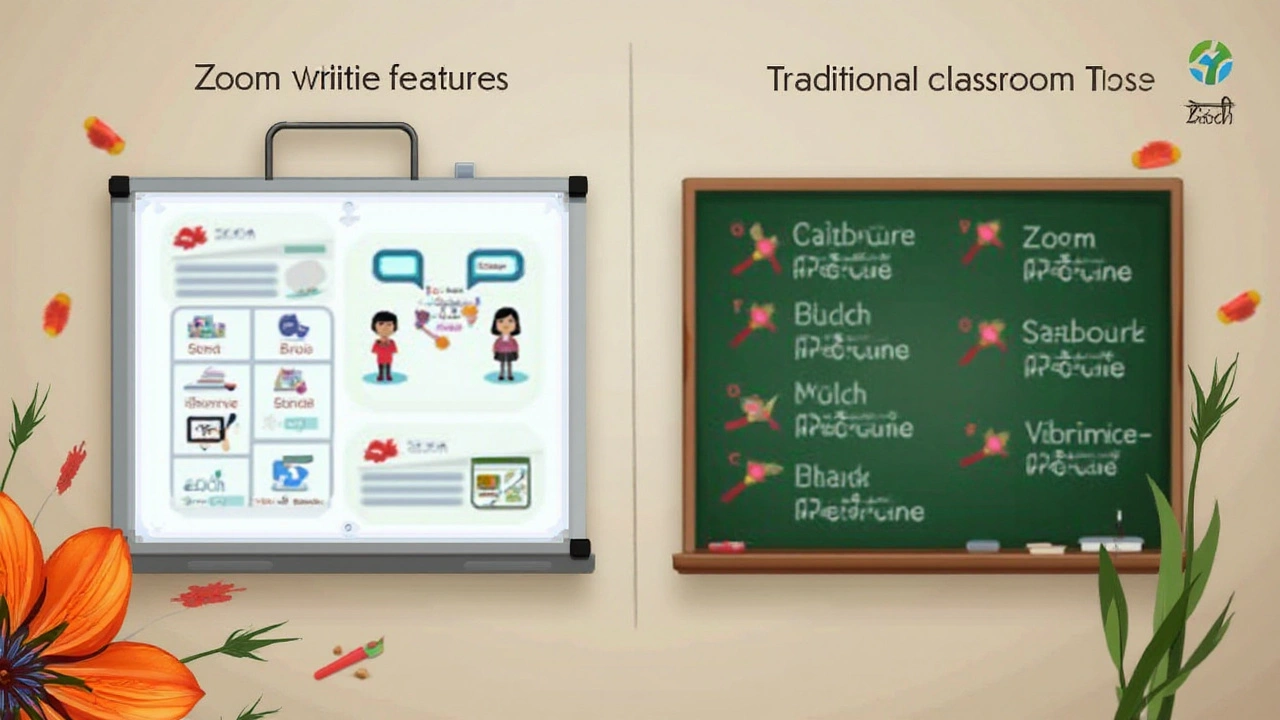When the world was hit by an unexpected pandemic, many turned to Zoom as a lifeline for communication and learning. From virtual classrooms to interactive sessions, Zoom quickly became an online classroom staple. But the question remains, is it truly suited for dedicated eLearning?
We explore how educational institutions have adopted Zoom and its role in shaping the future of online learning. While it offers an array of features like breakout rooms and screen sharing, how does it stack up against platforms designed specifically for education?
Let's take a closer look at what sets Zoom apart, where it excels, and where it might fall short. You’ll also find valuable insights on how to effectively use Zoom as an educational tool, making learning not only possible but engaging and fun.
- Zoom's Role in Education
- Comparing Zoom with Dedicated Platforms
- Strengths and Limitations of Zoom in eLearning
- Maximizing Zoom for eLearning
Zoom's Role in Education
During the COVID-19 pandemic, schools and universities across the globe scrambled to find solutions to continue educating their students. The platform that rapidly captured attention was Zoom. Its user-friendly interface and immediate availability made it a natural choice for many educators. Overnight, classrooms were transformed into virtual spaces where students from disparate locations could engage in learning, participate in discussions, and collaborate on projects. The accessibility of Zoom meant that education could continue uninterrupted, albeit from the confines of our homes.
Zoom's features lent themselves well to this new form of education. Teachers could create breakout rooms to simulate smaller group discussions, akin to those they might have had in a physical classroom. The ease with which instructors could share their screens allowed them to present material as if they were standing before a blackboard. These capabilities helped bridge the gap between traditional and virtual learning environments, ensuring that students still received a quality education even amid challenging circumstances. As educational institutions embraced these features, they began to see zoom not just as a stopgap solution but as an opportunity to innovate the learning experience.
While Zoom was not initially designed as a dedicated eLearning platform, its impact on education has been significant. A report by HolonIQ states that the demand for online learning tools surged by over 80% during the pandemic peak, with Zoom as a major contributor.* The platform’s capacity to handle large numbers of participants and easily manage meetings made it appealing not only for teachers but also for school administrators looking for scalable solutions. These dynamics spurred conversations about the future of education and whether technological integration should be a permanent fixture in academic curriculums.
"Zoom has altered the educational landscape, pushing institutions to embrace digitalization at an unprecedented pace," remarked Dr. Natasha Pearl, an education technology expert. "It's no longer just about replicating in-person learning but enhancing it with digital tools that can make education more inclusive and interactive."
The role Zoom plays in education has sparked various innovative approaches. Universities have used it to host virtual office hours, seminars, and even labs. Specialized features like polling during sessions allowed instructors to gauge student understanding instantly. Despite these advantages, some educators raised concerns about Zoom fatigue, citing the mental exhaustion of extended screen time. This calls into question the platform’s suitability for long-term use as a primary tool within eLearning environments.
Yet, as we move forward, the lessons learned from using Zoom persist. Teachers now have better access to digital resources and are more equipped to create dynamic, multimedia-enhanced lessons. As the demand for online learning continues, it's likely that platforms similar to Zoom will increasingly integrate with school systems to provide the ultimate hybrid learning experience. It’s clear that Zoom, while not the epitome of eLearning, serves as a powerful tool in the educator's arsenal, and its continued development and integration will be fascinating to follow.

Comparing Zoom with Dedicated Platforms
In the world of online learning, Zoom has made quite a name for itself, but how does it stack up against platforms designed explicitly for eLearning like Moodle or Blackboard? Unlike Zoom, which began as a video conferencing tool and gradually moved into the educational space, these platforms were crafted with education in mind. A tailored educational platform typically offers integrated learning management systems, allowing teachers to upload materials, track student progress, and administer exams. Zoom, while exceptional for real-time communication, lacks these in-built educational frameworks.
Let's imagine you are a teacher wanting to conduct a detailed assessment. On a platform dedicated to education, you can design quizzes, automate grading, and easily analyze results. Zoom would require a workaround—perhaps a combination of third-party applications—to achieve similar functionality. That said, Zoom’s simplicity and accessibility make it much easier for teachers and students to initiate and join sessions without extensive training, which has contributed significantly to its popularity during recent times.
Now, let us consider user engagement and interactivity, which are crucial in educational settings. Many dedicated platforms offer discussion boards, peer review options, and gamified elements that enhance learning. Zoom provides breakout rooms and polling features to foster interaction, but it could fall short when compared to the experience-driven model many students find motivating.
"E-learning platforms need to not only deliver content but also engage and motivate learners," said Dr. Tara Walker, an expert in online education. "It's about creating a community online, something Zoom can do but is not inherently designed for."
Despite these differences, Zoom partners with many eLearning platforms to integrate its virtual classrooms into more extensive systems. This integration allows schools and universities to benefit from the best of both worlds—the broad reach and intuitiveness of Zoom paired with the comprehensive educational tools of platforms like Canvas or Schoology. Virtual classrooms are no longer a linear, one-way transfer of knowledge. With the addition of Zoom, the option to livestream or bring in guest speakers adds tremendous value to eLearning experiences. What Zoom might lack in specialized features, it compensates for in flexibility and ease of use.
However, it's essential to recognize the specific needs of your educational context. If your goal is to facilitate an online book club, Zoom might exceed expectations. But if you're teaching complex subjects that demand structured learning paths and assessments, a platform designed solely for eLearning remains crucial. A balanced approach, using Zoom and dedicated learning management systems in tandem, can sometimes offer the most effective outcome. Schools need to weigh their goals and choose the right mix of technology to match.

Strengths and Limitations of Zoom in eLearning
Zoom has swiftly become a central player in the online learning space. Its user-friendly interface serves as a major advantage. Many educators and learners appreciate the platform's straightforward design that minimizes the learning curve and allows them to focus on content rather than technical challenges. Zoom also supports a wide range of devices, making it highly accessible. This feature is very useful in ensuring that education reaches a wider audience, from school students to university attendees and adult learners. A significant strength also lies in Zoom's flexibility in adapting to diverse educational needs, providing synchronous classes that can be recorded for later review, catering to various learning paces.
One of the standout features that attracts educators is the ability to create breakout rooms. These allow students to engage in smaller, more intimate discussions or team projects. The breakout room feature has been praised for encouraging collaboration, a crucial aspect of effective learning environments. “Zoom manages to simulate the interpersonal connectivity of a physical learning environment, making virtual learning more engaging,” remarks an educator from a local school. Additionally, Zoom’s screen sharing and live annotation tools give an enriching visual element to online classes, aiding in clearer instruction and lively discussion. However, it's important to acknowledge Zoom's dependency on stable internet connection which may not be available to all students globally.
Despite its strengths, Zoom also faces limitations when it comes to specialized eLearning functions. It lacks some tailored assessment tools, like quizzes and automated grading systems, which are readily available in dedicated eLearning platforms. Such features are vital in streamlining the educational process, allowing teachers to evaluate student progress efficiently. Security concerns have also been raised, especially in the earlier stages of its rampant popularity, where 'Zoombombing' disrupted several educational sessions. Although the company has worked diligently to address these issues, security remains an ongoing challenge as more features are added. In particular, the interface may not support the rich integration of curriculum materials or adaptive learning technologies as some might prefer.
Deciding If Zoom Fits Your eLearning Needs
For educators contemplating whether Zoom is suitable for their eLearning needs, it's crucial to weigh these strengths against its limitations. Zoom brings certain unparalleled benefits for real-time interaction, especially where immediate feedback and community building are essential. However, it might fall short for institutions seeking a customized, all-in-one platform that handles content delivery, student assessment, and analytics seamlessly. For schools already embedded within a robust learning management system (LMS), Zoom can complements live sessions, improving direct engagement with remote learners. Yet, for those starting out, integrating Zoom with a basic LMS tool can create a well-rounded experience for both teachers and students.
Maximizing Zoom for eLearning
In the world of virtual classrooms, Zoom has emerged as a powerful tool for educators and learners alike. Yet, maximizing its potential for eLearning requires some ingenuity and a few strategic adjustments. Understanding the platform's capabilities can transform a simple video call into an engaging educational experience. To begin with, instructors can make use of Zoom’s breakout rooms, which are perfect for fostering smaller group discussions. With breakout rooms, educators can divide students into teams to work on projects or practice new skills in a more intimate environment. Breakout rooms mimic the dynamic of physical classrooms, encouraging collaboration and participation, making learning immersive and interactive.
Additionally, screen sharing is a feature that many educators find invaluable. It allows teachers to share presentations, documents, or even entire screens with their students, enhancing the clarity of teaching materials. By using screen share, instructors can walk students through complex content step-by-step, ensuring everyone stays on the same page. To further improve engagement, educators can integrate various multimedia elements during their sessions. Videos, animations, and interactive quizzes can be woven into lessons to keep students interested and actively participating. Providing diverse content not only caters to different learning styles but also makes sessions more enjoyable.
For those looking to bring an additional layer of structure and accountability to their virtual classes, Zoom’s feature of live polling can be an excellent tool. Creating quick polls during sessions can serve as a real-time feedback loop, giving the instructor valuable insights into their students' understanding of the topics. This instant feedback can guide adjustments in teaching methods or prompt further explanation of specific concepts. Keeping students engaged through interactive content is key to effective online learning experiences. When combined with clear instructions and welcoming atmospheres, technological tools like this can empower educators to excel in virtual teaching.
"Education is the kindling of a flame, not the filling of a vessel." — Socrates
Maintaining the human aspect of education is crucial, and video conferencing tools must strive not only for functionality but also for comfort. Encouraging open dialogue and expression can create a collegiate atmosphere even through a screen. Educators should consistently invite questions and allow students to express themselves without the fear of technical difficulties. Reflecting on the feedback gained through these interactions ensures continuous adaptation and improvement of the learning process.
Setting clear guidelines and expectations from the onset can also alleviate confusion, minimizing disruptions during the session. Creating a digital code of conduct that details how students should address connectivity issues or interact during class discussions can streamline the entire learning experience. From simple cues such as “raise your hand” features to more complex techniques like idea mapping or collaborative digital boards, these guidelines facilitate smooth, interactive, and meaningful exchanges.
In conclusion, while Zoom may not specifically be designed as an eLearning platform, its features certainly provide the flexibility and tools necessary for educators to craft compelling virtual classrooms. By understanding and utilizing these features effectively, instructors can amplify the impact of their teaching and create vibrant learning environments that transcend the limitations of physical space.



